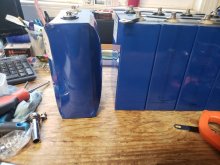jvbutter01
New Member
- Joined
- Aug 20, 2020
- Messages
- 207
Came home today and found my single cell battery on the charger ballooned up pretty good. Now what?
1) is it dead?
2) should I hook a fan up and discharge it?
a little history
I bought these new while back, put on charger set to 3.65v. Been on charger for few days. amps 4.62 has yet to drop off. I was expecting the amps to drop off as it charged up. I need to read up on my
thx
jim
1) is it dead?
2) should I hook a fan up and discharge it?
a little history
I bought these new while back, put on charger set to 3.65v. Been on charger for few days. amps 4.62 has yet to drop off. I was expecting the amps to drop off as it charged up. I need to read up on my
TUFFIOM DC Power Supply Variable 0-10A/0-30V
battery charger. Seems its not a monitoring type. only constant supply.thx
jim




